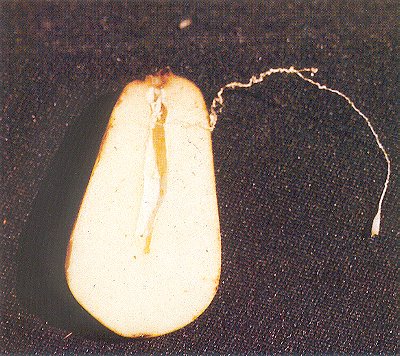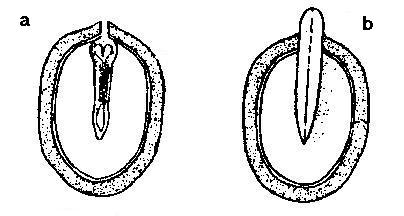
|
 |
|
showing coiled suspensor. |
of an Encephalartos embryo. |
Over the years I have heard many stories from nursery owners who had purchased thousands of cycad seeds and gotten little or no germination. One of the reasons the cycad liner business is so good is because many nursery owners have given up trying to germinate their own seeds. With the proper technique and an understanding of how a cycad seed works, germination of good seed can be close to 100%.
Once a cone is pollinated the pollen is drawn into the seed (ovule) by a drop of liquid. The pollen will stay in the pollen chamber for around three months. After this period, the pollen, which are actually motile sperm cells, swim to fertilize one of a few egg cells. As the embryo grows, a suspensor is formed (Figure 1). This is a coiled thread that is attached from the pollen chamber to the embryo. The embryo starts in the center of the seed and grows towards the pollen chamber. Until the embryo grows to full- length, the suspensor is in a hollow cavity in the center of the seed. All of this can be viewed by cutting a seed in half. Figure 2a shows the seed at this stage. A seed will not sprout until the embryo is at full length. This is the big secret to cycad seeds. Figure 2b shows the solid 'push' exiting the seed.

|
 |
|
showing coiled suspensor. |
of an Encephalartos embryo. |
Seeds will be held in the cones for 6 months (Encephalartos) to 18 months (Dioon merolae). The table shows the average time cycad seeds are held in the cone.
|
|
|
| Ceratozamia |
|
| Cycas |
|
| Dioon |
|
| Encephalartos |
|
| Macrozamia |
|
| Stangeria |
|
| Zamia |
|
There are always exceptions to every rule. As an example, there are Zamia species that will hold their seeds for 18 months.
After the cone falls apart, the embryo continues to grow. From my own experience, in most cases, the seeds are ready to spout 12 months from after pollination of a cone. An Encephalartos cone will fall apart in 6 months, so the holding period or storage time will be about 6 months. Usually the holding period for Ceratozamia seeds is around 3 months. Zamias will usually sprout after one month, and Dioons will usually sprout immediately. I have noticed that a cone with a partial seed set will take longer to fall apart. Once I had a Ceratozamia cone that stayed on the plant for 15 months. I tested a few seeds, and found that some had sprouted in the cone and died. This also showed that 12 months might be the optimum time for seeds of this genus to be ready.
With so many seeds on the market, usually coming from brokers, it’s hard to tell what you are getting. If you cut a seed open, it will show you how long you should wait to plant or if you should plant it immediately. Many people would shudder at the thought of wasting a seed, but most people have a tendency to rot the seed that is waiting to germinate. If someone buys 100 seeds, cutting one seed open may save 50.
The quality of storage is also very important. Cycad seeds like to stay slightly moist. If the seeds dry out to an extreme, the developing embryo can die. After awhile the soft, inside part of the seed will separate from the hard shell. Floating seeds in water will usually tell if seeds have gone bad in the hands of others. Sometimes "floaters" can be soaked in water for a couple of days and be saved. Most Zamia and Cycas seeds can be held with the fleshy seed coat on until it is time to plant. This naturally keeps the seed moist. Ceratozamia and Encephalartos seeds should be thoroughly cleaned and stored in a cool place. Some people prefer adding fungicide.
When ready to plant, clean all seeds thoroughly. If a seed has even a little bit of the seed coat still on it, fungus can attack and kill the seed. Before planting the seeds, soak them in water for about two days. For optimum results, the medium should be as sterile as possible. There are countless ways people try to germinate cycad seed. Some people plant the seed on top of the medium. Others plant half of the seed into the medium. In this manner, the seed is absorbing moisture. If the sprouting end of the seed is left uncovered, fungus cannot enter easily. My favorite method is placing the seed on top of sterile sand, then covering with Perlite. The moist Perlite keeps the seed moist but not wet and is sterile enough not to promote fungus. Depending on the amount of shade and temperature in the growing area, seeds should be watered one to three times per week. Some people prefer using bottom heat to help germination, but I have found that a greenhouse in summer is warm enough to insure proper germination. I have heard several horror stories from people who had mechanical problems with their heaters and cooked all their expensive seeds. I prefer using natural heat.
Cycads are rare enough as it is to risk the unnecessary death of seeds. With proper storage and planting procedures, cycad seed germination can be maximized. Even if only 1% of all the cycad seeds that die each year could be saved, millions of extra cycads would be produced each year.
